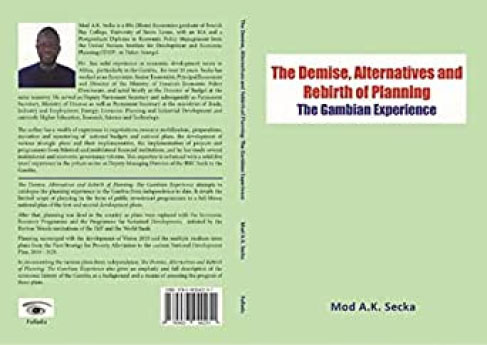
The Gambian Experience, Fulladu Publishers, 2020, 232 pages.
This is a dependable book on a little discussed issue: economic planning and its role in building a sustainable growth in The Gambian economy. From the time of the US Thirteen Colonies to the colonial economies of Africa and Asia, to the Communist Bloc and the Capitalists arc, over history, nations have always sought an economic model which would solve their economic woes, and bring prosperity to their people.
Therefore, economists and historians have always indeed argued about the demerits and merits of economic planning: the arch disciples of Adam Smith, the father of Capitalism, see it as unnecessary as economies must be allowed to weave their own way out of the labyrinth until the perfect model is found and adopted. Others take that the powerful hand of government is needed to help lay out a plan which will deliver the economic and social goodies for the citizens. In this well researched book, the author Mod A.K Secka, a seasoned civil servant and economic planner, argues that planning is part of the due diligence of Gambian economic development ‘from Independence to date’(p.11). The book is divided into four chapters, in addition to an overview and a conclusion.
In Chapter One, the author gives an intriguing background to The Gambia’s post independence history until as recently as the change in government through elections of December 2016, which the author rightly calls ‘a groundbreaking development’(p.22). This is good as politics cannot be separated from the economics of a nation. A strong point in this chapter is that the author ticks off the levels of economic performance of the country starting from 1965 to date; from when ‘The Gambia was considered as a country that ‘was not viable as a nation state’(p.22) due to poor monoculture economy, to the first period of growth in the 1970s, when tourism and ‘expansion of the public service and investments’ generated jobs and hope for the new nation.
Indeed, according to the author this hopeful trajectory was maintained without wavering deep into the 1970s and early 1980s. ‘The balance of payment position of the country was largely in equilibrium… and reserves of the country were built to comfortable levels’(p.27). Indeed, these were the Halcyon days of the post independence Gambian economy!
In Chapter two, the author gives a detailed historical review of economic planning in The Gambia from the 1960s to the 1980s. The author surmises that planning as a process of building a viable economy came about largely because of the very doubtful state of the Gambian economy at independence in 1965. For example, the country had to depend on ‘external assistance’ (p.37) from the UK, in particular, called the Grant-In-Aid Scheme, and also expatriates to help run many departments. One way of soothing these challenges according to the author, was to prepare public investment programmes and ‘a series of Development Plans’.Thus, here we see a nuanced meaning between the two: ‘public investment programmes’ were like micro Development Plans.
The author gives comprehensive descriptions of the various Development Plans of 1974/1975-1980/1981; the Second Development Plan of 1981/1982-1984/1985; and the Development and Structural Adjustment Programmes from 1985-2021 including the Poverty Reduction Strategy Papers (PRSPs). For each Plan, for example, he paints a picture of the economic situation at the start of the programme, then gives the volumes of investment in terms of capital and manpower into the Plan, and then gives the bilan or the results after the Plan has been implemented. For instance, for the First Development Plan, a total investment of D144.8 million was envisaged. ‘Almost 70 per cent of this projected investment was to be financed from external sources’(p.38).
This in fact was one commonality for all the Gambian Development Plans, including the Public Investment Programme of 1963/1964, which was financed mainly by the UK. Development Plans were meant to cater for the needs and aspiration of Gambians but using foreign resources. Later in this chapter, the author gives a good account of the famous Economic Recovery Programme (ERP) of 1985-1990(p.75), when the Gambian economy having hit the doldrums had to be rescued by the Bretton Woods Institutions in the form of a comprehensive bailout dependent on wicked conditionalities like retrenchment of workers (p.83) and introduction of flexible exchange rates. According to the author, the ERP and its follow up programmes like the PSD were a success story of The Gambia, despite the bitter taste they occasioned in the mouths of many Gambians, because inflation fell by 10 percent and government budget deficits were reduced (p.95). The astute civil servants such as Bala Gaye, Mamour Jagne, Alieu Ngum, Juka Jabang, Bammy Jagne under their able boss S.S Sisay deserve our thanks here.
In chapter three, the author takes us through the experience of the various Development Planning process of the 1990s through to the National Development Plan (NDP) of the transition government of President Adama Barrow. He weaves a complex but not complicated web of how the various Plans fitted into each other; how they complemented, and how the failures and success of one planning process created a new one. For example, the geopolitical impact of the army coup of 1994 including the drying up of external funding due to anti coup sanctions led to a new planning process called Vision 2020 which ‘defined The Gambia’s ambitions from 1996 to 2020’)p.103). Certainly, with a plethora of Plans and Visions, (PAGE, PRSP1, PRSP II, NDP) there was overlapping in implementation, and what I can call Plans Fatigue which is why as time went on, even the most hardened Planners like the author could hardly catch up with the new acronyms and abbreviations of these Plans.
In chapter four, the author gives a summary of the impacts of the various plans, especially President Jammeh’s Vision 2020, and the earlier ERP and PRSP. Here it is clear that The Gambia has since independence never lacked a coherent Economic Planning process. In fact, twice since 1974, separate Ministries had been created for Economic Planning and in the late 2000s, a National Planning Commision was created. Therefore, he concludes that the will to plan ourselves out of economic problems has always been there. What has been lacking is the required human and financial resources needed to implement the plans and projects and programmes. Even when there is financing, there will be absorptive capacity challenges.
The book is a fine read and very informative. Largely because it came out of an academic project of the author’s, but also because the author knows this subject very well. As the longest serving Permanent Secretary in The Gambia Civil Service, he spent many years at the Finance, Trade, Energy and Economic Planning Ministries. He was an active participant in many of the plans discussed in the book and therefore has dependable insider knowledge.
I strongly recommend this book to students of Gambian economy, planning and economic history. The book stands out as one of the very few comprehensive reviews of The Gambia’s search for a suitable economic model since 1965. More, replete with a glossary, tables and an index, the publication has the ingredients that make a good book.
The book is available on Amazon’s Kindle publishing: kdp.amazon.com and will soon hit the stand at Timbucto and other outlets.
HassoumCeesay, Historian and Curator.
So, go for your copy!
Available at Timbooktoo tel 4494345





